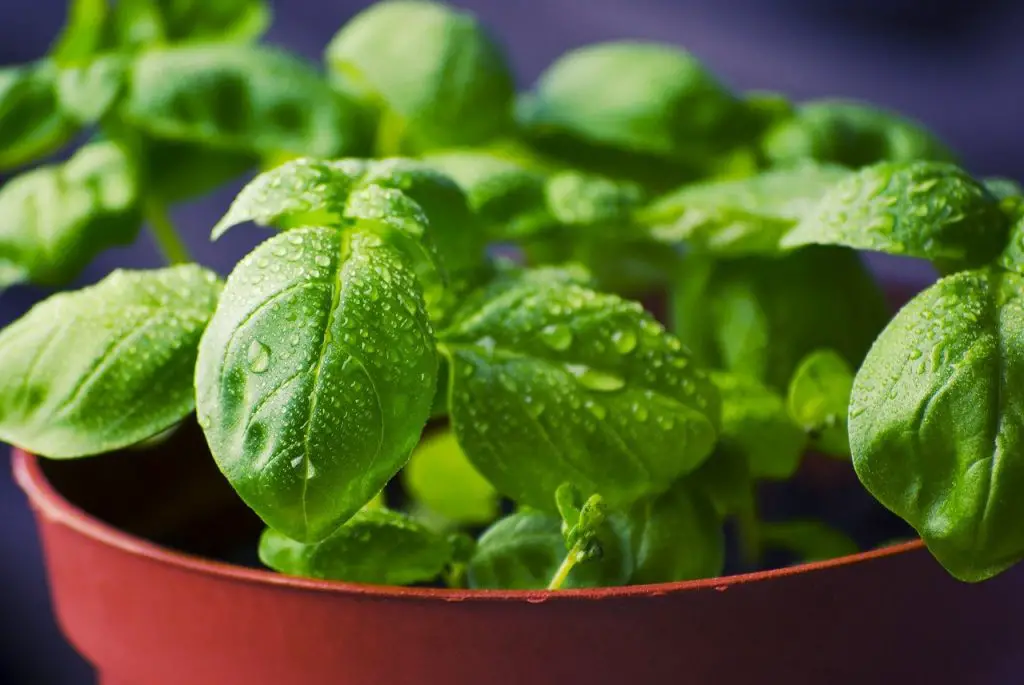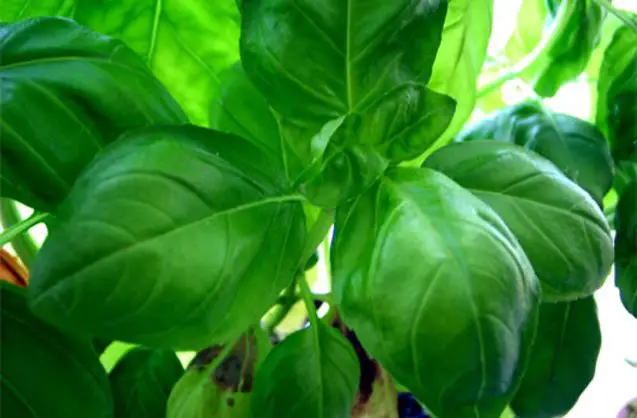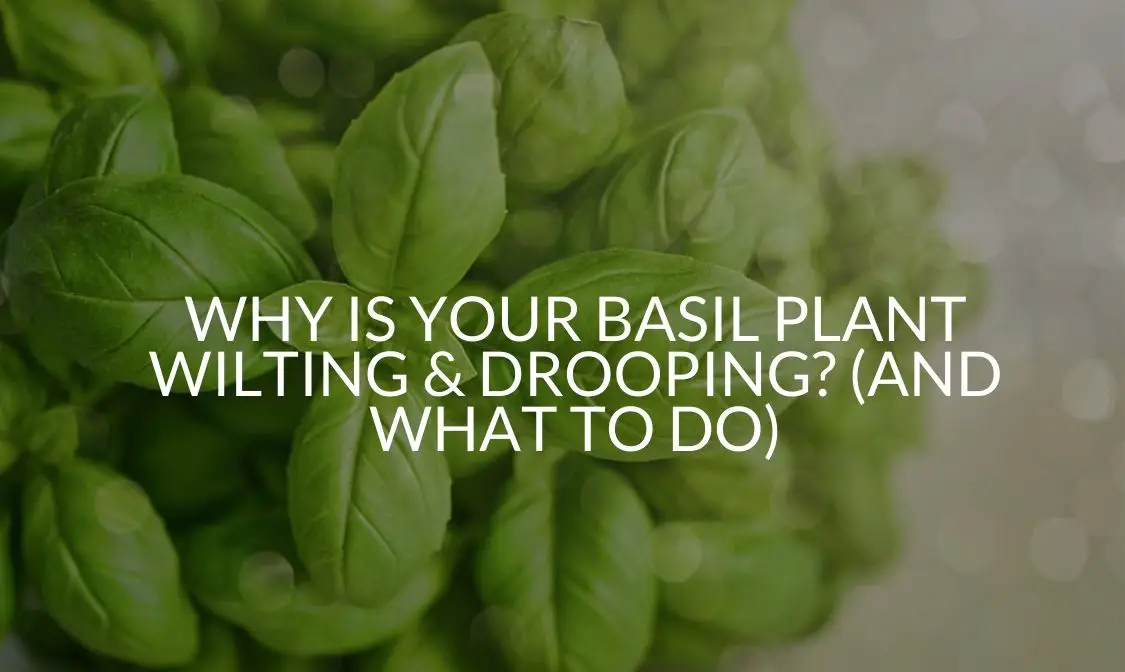Basil is a great and wonderful herb to grow around your home. It has a myriad of uses in food and homeopathy. You can add it to Italian dishes in tomato sauce or pesto. You can even consume it for treating problems related to digestion and high blood pressure.
So, you’ll want to grow this amazing little plant and keep fresh and dry handy. But, like with all plants, sometimes problems happen when growing them. Basil going limp and lifeless is one of the most common. There are a number of culprits that cause wilting or drooping.
Why Is Your Basil Plant Wilting/Drooping?
When you first notice wilting or drooping, you want to evaluate the basil’s watering schedule along with ensuring the proper amount of sun exposure and soil. Basil is part of the Lamiaceae family, which means it’s a cousin to lavender, rosemary and mint. Basil must have the similar conditions as its native Mediterranean habitat in order for it to thrive.
The soil should be loamy and sandy while maintaining a certain amount of moisture yet doesn’t get too dry. Sunshine exposure is also important and will vary depending on whether the basil is a seedling or full-grown adult. But other things can hurt basil too like pests, fungal disease and EMF radiation.
Watering & Sunlight
The amount of light and moisture a basil plant receives should always be your first consideration when it starts drooping. If you have young seedlings, don’t give the basil full sun until it’s mature. You will notice drooping in seedlings around the edges they’re getting too much light.
If it’s mature, it should get six to eight hours of full sun every day. Anything more, or less, may cause your basil to wilt. This includes too much shade. Overwatering, including humidity, is sure to affect the basil and root rot.
Summer Treatment
In the summer when its dry, you can water basil rather freely without too much worry. But you want to make sure the soil feels almost dry before you water. It shouldn’t have too much water, but there shouldn’t be too little water either. Basil is very much like mint that way; moisture levels have to be perfect and even for its survival.
Avoid Water On The Leaves
Always take great care to not get any water on the leaves by watering at the base of the plant. Don’t use sprinklers or sprays as it can damage the leaves and cause wilting. If you notice excess moisture, pat it dry with a clean cloth or paper towel.
Soil & Potting
Sandy, loamy soil is best for basil, like anything from the mint family. Ensure the soil is a good blend of gritty sand and nutrient-rich soil that’s free of clay. The sand should have a thick grit and not be on the fine, silty end of texture. Fine sand will clump together and be just as bad as clay; preventing good drainage.
If you’re going to grow basil in a pot, make sure it has a sufficient drainage hole. Although any material that comprises the pot is usually okay, basil loves living in unglazed terracotta, wood or some other natural substance. There are some reports of wilting with basil in pots made of things like plastic.
Also note that if the soil is too dry, basil will wilt. So, underwatering can become a problem too. That’s why it’s so important to maintain even moisture throughout the soil while allowing it to drain. This is the key to growing perfect, healthy basil free of infestation.
Pruning, Picking & Trimming
More than most others in the mint family, you must prune basil often and on a consistent basis. Drooping can and will occur if it’s crowded by its own leaves. Whenever six to eight leaves appear once seedlings produce their first six leaves, prune only above the second set. When you repeat this process, always prune back to the first set of leaves.
Every six weeks, pinch off the center shoot to stop flowering. Cut off any visible blooms if you wish to use the plant for eating or medicine. This retains the flavor along with all the good phytochemicals attributed to its healing benefits.
Pests & Disease
Most plants are susceptible to pest and fungal infestations. This is true if they’re grown in the garden or there’s issues with water, like proper drainage and the plant receiving too much water. In other words, water attracts problems that can develop fast if not observed and caught right away.
Wondering why your Basil Plant is dying? Click here to find out why!
Many conditions and issues with wilting or drooping in basil arise from some type of infestation:
- Root Rot – Drooping basil is often a symptom of overwatering and can kill the plant if not taken care of right away.
- Insects – Things like spider mites, aphids, and other bitty critters like caterpillars, beetles, slugs, and grasshoppers will consume all the moisture, nutrients, and sap. This is also a common problem with drooping basil.
- Fusarium – Sometimes younger basil experiences a fungal disease called fusarium. If the leaves are in a cup-like shape with yellowing and decreased growth, it’s most likely fusarium. If planted outside, this could be problematic because fusarium can remain in the soil for eight to 12 years.
- Leaf Spot – If brown, wet spots are on the leaves along with an appearance of wilting, your basil could be suffering from Leaf Spot, which encompasses a number of fungal diseases. It happens because water gets onto the leaves either when you water or from the rain.
Radiation from EMFs
If your potted basil has a spot next to a laptop, tablet, personal computer, mobile device or Wi-Fi router, the EMFs (or electromagnetic frequency waves) could be damaging the plant and preventing its growth, thereby making basil wilt.
Several years ago, five Dutch high school students did a study and discovered that plants won’t grow next to internet routers because of the harmful effects of radiation. Other studies conducted in 2016 included a variety of plants with other devices like smartphones, tablets and computers.
Wilting is a frequent and unfortunate problem that results from exposure to massive amounts of EMF radiation for long periods of time; this includes basil. But consuming fresh, healthy Holy Basil can provide a certain amount of protection in humans from the harmful effects of EMF radiation.

Why Is Basil Plant Wilting After Being Repotted?
Basil wilts after repotting because the roots are experiencing shock. But, this happens with all plants after transplantation to some degree. That said, basil tends to be a primadonna when replanted in a severe and dramatic way.
Don’t worry about or touch the basil. It’s getting re-accustomed to its new home and needs a few days to adjust. If it’s been longer than a week since repotting and it looks like it’s struggling, you’ll have to check the conditions and environment along with any possible root rot or other disease and infestation.
And, of course, as previously discussed, sunlight will also be important. It must have full sun every day during these initial stages after repotting so that it can thrive in its new environment and take better to the soil.
Basil Doesn’t Like Repotting
In some cases, your basil won’t like transplanting at all and will die from shock. This is why whenever you plant basil, make sure you put it where you intend for it to stay. It’s also why it’s not advisable to dig it up when the temperatures start dropping at the onset of winter, it won’t survive. You are better off harvesting what you can and cutting back the rest.
How Can You Revive Wilted Basil?
You can save most drooping or wilting basil by taking care of its conditions and environment, but you want to be sure what the problem is before acting on a solution. Whenever you notice your basil wilting, always first check the three main areas: light, soil and water.
In cases of infestation, you can pick off the bigger bugs like caterpillars and beetles. But you’ll still want to use an insecticidal soap on the leaves to ensure complete removal. Pay special care to leaf undersides while keeping an eye on pests. Remember, always follow instructions, don’t spray it when it’s 90°F or hotter and when the plant is in direct sun.
Remove the Dead Stuff
If you think it’s salvageable, remove all brown, dead growth. This includes cutting off stems and leaves. You can pick it off with your fingers or use a clean, sterilized set of shears. But, you want to make sure that the browning isn’t coming from a more serious problem like pests or fungal disease.
If there is disease, remove all affected leaves upon first sight of it to ensure the plant retains its life. You can also apply a fungal spray to save the basil if the disease is mild enough. If more than 60-70% of the plant is overtaken by leaf spot, you’re going to have to throw away the plant.
Check the Soil & Airflow
Then, make sure the soil drains well and isn’t too moist or too dry. Pour off any standing water in the drainage dish below the pot.
If the soil is too moist, you can put a piece of dry, clean paper toweling between the pot and drainage dish. Replenish the toweling once saturated. You can also keep a small oscillating fan nearby to ensure proper airflow.
Proper Sunlight
Of course, sunlight is important. Basil shouldn’t be receiving too much shade but it shouldn’t have more than eight hours of direct sunlight. Depending on your hardiness zone and how much sunlight is available during the warmer months, you’ll have to either adjust the basil’s location or create a structure to protect it.
Moisture & Humidity
When the environment is very hot and humid, put mulch around the base of the plant to retain moisture. Because basil should be in well-draining, keep potted basil on a rack without a drainage dish underneath. Allow it to sit an inch or two above drainage collection. This way, effluence shouldn’t be a problem when humidity is uncontrollable.
If moist soil is a serious concern, try keeping a small oscillating fan in the vicinity to ensure proper airflow, absorption and drainage. If the basil is still wilting with balanced soil, then it could have already developed root rot or there’s fungal disease.
Soil Check
Inspect your soil and, if necessary, get it tested. It should have a neutral pH with slight acidity. If you notice thick chunks of clay or clumped sand, you must replant the basil immediately. Make sure the soil is sandy and loamy but rich in nutrients. Only lightly water the basil when you replant to ensure it recovers.
Then resume normal watering, taking care that the soil has the right amount of moisture and only watering when almost dry to the touch.
Temperature Issues
If you live in a colder climate, the basil could be too cold. While indoors for the winter, be sure to give the plant a grow light and that it stay out of the direct path of drafts and breezes. So, it’s not a good idea to keep it next to a window or where there’s traffic in and out of the area it sits.
For basil grown outside, pay attention to weather and severe changes in temperature. It can survive a little bit of frost, but, if you know it’s going to drop below freezing, harvest what you can. It will not tolerate anything under 32F for too long. There is no saving it unfortunately.
Humidity
In places where humidity is a factor, you will have to adjust watering and fertilizer. Use mulch around the base of the plant to retain moisture for as long as possible and avoid watering until it’s near bone dry.
You will also have to watch the leaves for water build-up. Wipe them with a clean, dry paper towel every so often if you do notice any moisture pooling up.

How To Prevent Your Basil Wilting/Drooping?
The best way to prevent your basil from drooping is to control it before it can even begin. This means purchasing disease-resistant seeds that feature testing against fusarium. If you’re growing it from seed, be sure to watch and care for it at every stage of growth and baby them in the beginning.
You can prevent fusarium growth by purchasing disease-resistant seeds that include prior testing for fusarium. Using these kinds of seeds should prevent any other fungal infections from forming and taking hold of the plant too, like leaf spot.
The best preventative measure against root rot is to only water when the soil feels somewhat dry but not bone dry. Potted basil should never sit in standing water.
Where Not to Keep Basil
Don’t keep your indoor basil next to any mobile devices or your internet wireless router. You will have to either find it a new sunny window spot or move the device or router. If you don’t, the plant will wilt and die.
Also, if you have to have it indoors for the winter, give it a good source of light and heat, taking care to keep it out of the way of intense cold. This means not putting it in a window or near a door with access to the outside.
When you water the basil, watch the drainage dish for any excess water that may collect there. Always pour it out the moment you notice it. You don’t want the basil sitting in standing water for any amount of time to prevent root rot from developing.
Final Considerations
Basil isn’t a touchy plant to grow, but it does have its own set of requirements and preferences that it has to have. If you can keep them all in mind while you care for the basil, it will stay with you for a very long time, providing wonderful flavors to your food and providing alleviation from many health issues.
It’s important to keep in mind it’s native Mediterranean habitat and try, as best as possible, to reproduce that kind of environment for your basil. Consistent pruning and checking for pests or disease will keep your basil vibrant, large and beautiful for years, especially if you grow it in a pot.
Best Assurances & Practices
The best way to make sure your basil doesn’t experience any serious issues with pests and infestations is to prevent them from the get-go. Buy disease-resistant seeds, make sure seedlings don’t get too much sun and always ensure the soil is a loamy, sandy mix.
It’s location will also play a role in preventing your basil from drooping or wilting. Never keep it near a door or window in winter and avoid putting it near any mobile devices or your internet router. Be mindful of sunlight, ensuring it gets no more or less than eight hours a day.
Sources
- https://www.almanac.com/plant/basil
- https://homeguides.sfgate.com/causes-droopy-leaves-basil-33951.html
- https://botanicalbalcony.com/basil-plant-wilting/
- https://www.gardeningknowhow.com/edible/herbs/basil/fix-droopy-basil-plants.htm
- https://www.ncbi.nlm.nih.gov/pmc/articles/PMC4769733/
- https://draxe.com/health/electromagnetic-radiation/


Loved this post! I’ve been struggling with my basil plant for weeks, and all the tips you provided about checking the soil moisture and ensuring proper drainage were super helpful. I had no idea that overwatering could be such an issue. I’m definitely going to try the soak method you suggested! Thank you for the great advice!